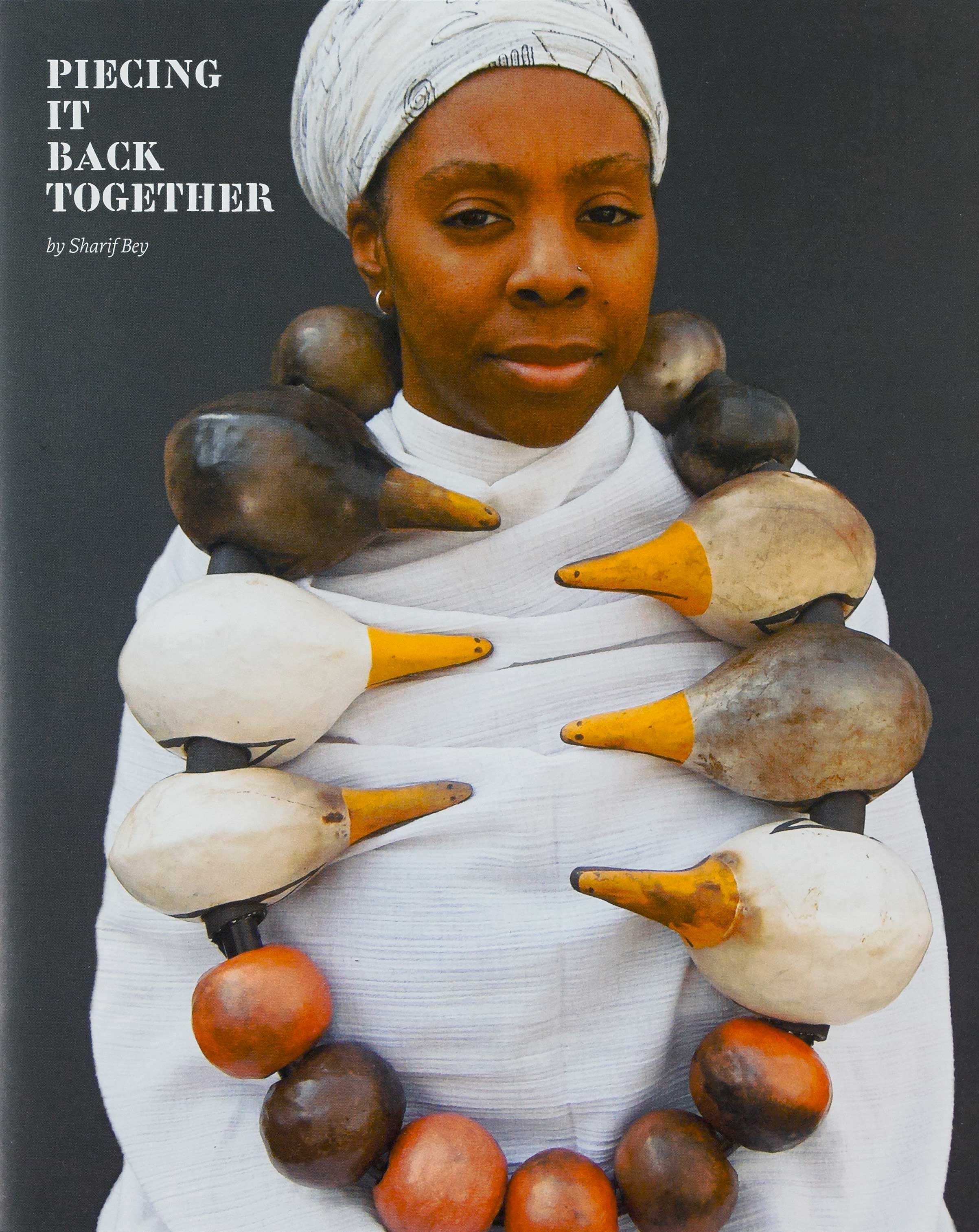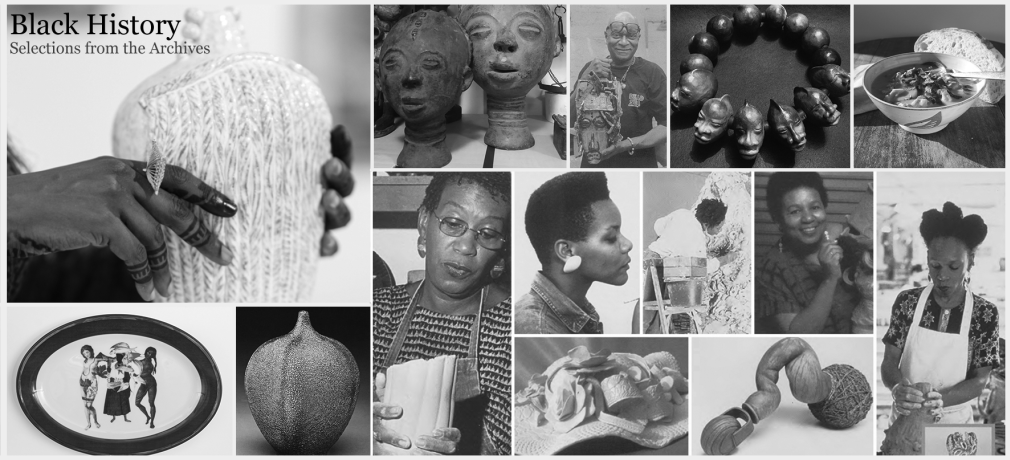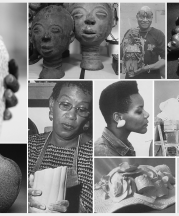Black history is an expansive legacy that is so much more than a month. However, February is officially designated for celebrating it, and Studio Potter takes a closer look at the contributions Black ceramists have made, and continue to make, to the richness of American ceramics. Many more articles by Black artists exist in the ninety-plus issues of our print journal, and we are working to bring them out of their print and PDF versions to make online, scrollable, shareable, mobile-friendly versions. If you are a current member (subscriber) of SP, you can login to our site and click on "digital issue" on any issue page to view the PDF version. This collection does not represent our full archive of Black authors and artists, and is an evolving and growing document of our contributors.
Volume 10, Number 2, June 1982 - "Black Crafts"
Although since the mid-fifties, and especially since the sixties, there has been a great upsurge in doing crafts, there still has not been enough of a support from the masses — the people — for the survival of the craftsperson, Black or White. It's a problem the artist has in this society. Then you overlay the whole racial thing, and it becomes even more difficult for Black people.
As a part of his regional interviews series, Gerry Williams visited several artists from Mississippi and published transcriptions or excerpts of those recordings. The section "Black Crafts" is by Dr. Grace Hampton, who began her career as an arts educator, worked at Jackson State University, Jackson, Mississippi, and as the assistant director in the Expansion Arts Program at the National Endowment for the Arts, before moving on to Penn State University. Learn more about Dr. Hampton's life and career in this Penn State interview.
Volume 40, Number 1, Winter/Spring 2012 - "Piecing It Back Together"
[Don] Reitz said that he doesn't make vessels, he makes what he calls "sculptures of pots," a way of paying homage to the history of the vessel. This statement changed my outlook on the process and representation of contemporary crafts.
 Artist Sharif Bey discusses the challenges of juggling family life with studio life and education in this 2012 article. Bey is now a dual associate professor in art education and teaching and leadership in the College of Visual and Performing Arts and Syracuse University’s School of Education. His studio work ranges from decorative functional pottery to conceptual ceramic works influenced by ritual and African-American identity.
Artist Sharif Bey discusses the challenges of juggling family life with studio life and education in this 2012 article. Bey is now a dual associate professor in art education and teaching and leadership in the College of Visual and Performing Arts and Syracuse University’s School of Education. His studio work ranges from decorative functional pottery to conceptual ceramic works influenced by ritual and African-American identity.
Volume 42, Number 1, Winter/Spring 2014 - "Reflections On Legacy"
From my family's example, I developed a strong work ethic and the sense of industry and frugality needed to maintain my own ceramic studio practice. [...] My family's appreciation for the land, learned through cycles of cultivating, growing, and harvesting, influences the way I use my environment as a source of inspiration and a point of departure.
James C. Watkins describes how growing up in a farming family during the 1950s and 60s in Alabama influences his ceramic work. Watkins maintains a studio and gallery in Lubbock, Texas.
Volume 45, Number 1, Winter/Spring 2017 - "Sallah Jenkins: Mother, Artist, Creator"
I first started creating and doing art because I was a mother of eight. I never understood the term “starving artist” because I took care of eight children by making with my hands.
In this article, author Sarah McCann highlights the accomplishments of Sallah Jenkins, a long-time Baltimore Clay Works artist and educator. Jenkins found not only a way to support her family, but also life-long joy and fulfillment through both arts service and personal artistic exploration.
Volume 28, Number 2, June 2000 – Leroy Johnson
"I'm addressing a black audience, trying to wake them up and become aware of things."
"I've shown my work all over, in Israel and here to many white audiences. Often my work has dates to signify historical moments in Black history."
Digital Publication
During my experiences, I thought about a church song’s chorus: “You are the potter and I am the clay, make me and mold me, this is what I pray.” My theology has always been about wrestling with the text and interpretation. My background in wheel throwing, in particular, sheds new light on this Biblical metaphor.
Contemplating specific qualities of handmade ceramics fosters connections, embodies values, and provides comfort. I look to my experiences, both as a maker and as a user. Some memories trace back to my childhood, while others are more recent, rooted in conversations with those who integrate functional ceramics into their daily lives.
What makes a beautiful pot? The same thing that makes a beautiful person. Confidence.
Many of us are drawn to clay because of its capacity for creation, but it also humbles us. We can never be entirely certain. To be committed to ceramics is a commitment to the ebbs and flows in our life/studio balance, with our bodies, with our facilities, and with the tools and materials that are precious to us.
The final resting place of these effigies became an ancestral grove, "till the yard smells of ghosts," until it was disrupted by colonialism. For that, I grieve for the disturbed lost souls but rejoice that a child of the diaspora reconnects with the echo of home.
This cinematic volume will be steep reading terrain for all but the most empathetic, relentlessly inquisitive seekers of pottery forensics. Lacking such scholarship, crocks and jugs sit mute – defying us to imagine their origins: that synapse between touch and its evidence. To date, we have no comparable documentation of a single potter’s life.
Trophallaxis focuses on the breast as a site of labor. In that, there is the juxtaposition of comfort and discomfort, familiar and unfamiliar: the cracking nipples and boot prints showcase bodily violence and the physical impact of breastfeeding. Fecund breasts with gold-plated areoles and nipples, constructed from terracotta, porcelain, antennae, and epoxy, suspending from the ceiling.
We’re moving closer and closer to that craftsman ideal but as a collective rather than as individuals. As a group, we are presenting our best in the spirit of social consciousness. We are honoring the traditions of the craft. We are passing knowledge on. Can shokunin apply to a collective? There is craft not only in the creation of pottery but also in the creation of community. We’re striving for both.
"I consider design an approach that needs and includes art. Many of my projects started as works of art that evoked the dynamism of African narratives. My creative process and the development of the projects have made me answer people's needs, such as tableware that tells their stories." – Faty Ly
As I look ahead to life after the military, I find myself reflecting more on a career that was unexpectedly full of art. By honoring those with whom I served and their families, I was able to grow as an artist and, for the most part, keep up with art industry trends. I realized that even though I enjoyed my time as a soldier, whether good or bad, I was happiest whenever the things I was doing involved art.
What I learned while centering the clay and obsessing over the clay-to-water ratio in class for weeks is that clay particles are like platelets; water and earth dance around and are compressed in the process of sculpting. While the goal is cohesion, it starts as a suspension. White supremacist capitalist patriarchy, not to oversimplify it, is in suspension, as it is multiple different ideologies pulling apart rather than binding together. I learned this profound lesson from Simone Leigh’s "Jug" (2014).
We are also past the arbitrary distaste for the decorative, the feminine, humor, and cuteness (among other aesthetic categories), which allows narrative content to flourish in the work of artists like Lindsey Lou Howard, Jennifer Rochlin, Roberto Lugo, Woody De Othello, Emily Yong Beck, Ruby Neri, and so many others. This month's FREE article.
This month's FREE article. It's a good place for artists to explore – those tender, unsure, and vulnerable places within ourselves. For one thing, it keeps us all humble. One thing I’ve noticed in these explorations [is that] we get universal. I often say to my students, "Your very individual story is what’s going to become your universal story."
We asked Winnie Owens-Hart to recommend several ceramic artists to accompany her forgoing interview "Inside the Pink House – A Conversation with Winnie Owens-Hart." She chose the following seven ceramic artists: Martha Jackson-Jarvis, Sana Musasama, Yvonne Edwards-Tucker, Janathel Shaw, Syd Carpenter, Teresa A. Williams, and Barbara Madden-Swain.
I used to go to craft fairs. I remember going to the first Richmond craft fair, where I was the only black ceramics exhibitor. As I remember it, for a long time at NCECA conferences, Jim Tanner, James Watkins, and Richard Buncamper, and maybe two or three more African American students I did not know and I were the only blacks. White people would often come by at fairs and say, "You do ceramics? I've never heard of anyone black doing ceramics." I'd say, "Well, you haven't been around." Of course, I knew a lot of blacks doing ceramics.
"I may start with some ideas and questions, but the wisdom is in the soil, just like the wisdom is in the clay. This properly humbles me, reminds me what my capabilities are, what my limitations are, and how generous the material is, how fortunate I am to continue exploring."
LETTERS TO THE EDITOR
Your thoughts, opinions, and experiences are valuable, and we want to hear from you. Submit your "Letters to the Editor" and let your voice resonate with our diverse community.
Whether you have a strong viewpoint on a recent article, a local issue, or a global concern, this is your platform to express yourself. Share your insights, challenge perspectives, or simply share your personal experiences that could inspire and enlighten others.
GUIDELINES:
- Length: Keep it concise. Aim for 100 to 900 words to ensure your message is impactful.
- Clarity: Clearly state your main point or argument. Be specific and avoid jargon to ensure your letter is accessible to all readers.
- Respect: While we encourage passionate opinions, please maintain a respectful tone. Constructive criticism fosters meaningful dialogue.
- Relevance: Ensure your letter is timely and relevant to our readership.
- Support your claims: Supporting your claim ethically demonstrates a commitment to truthfulness and transparency. Misleading or baseless claims can erode trust, while well-supported arguments contribute to a more honest and open exchange of ideas.
HOW TO SUBMIT: Email your "Letter to the Editor" to editor@studiopotter.org with the subject line: "Letter to the Editor Submission - [Your Name]."
Letters need to be received one week before our publication release (all Studio Potter articles are released on the first of the month). Letters will be reviewed by Studio Potter staff. Selected letters will be featured in our upcoming issues, providing you with a platform to engage with the community and influence the discourse.
Thank you for being an essential part of Studio Potter. We look forward to reading your compelling letters!

 Share
Share

